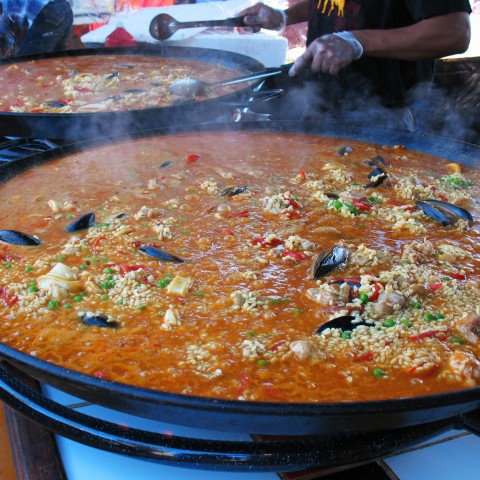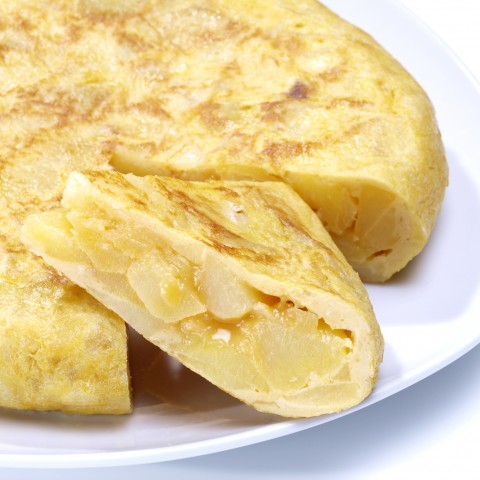
Food and culture are typically linked to each other, and this is very true in Spain. In fact, Spaniards are proud of their cuisine. If you ever visit Spain, there are some dishes that you definitely need to try, some of which vary by region.
In this article, we’re going to tell you about some of the most famous Spanish recipes, as well as some lesser-known dishes that are still worth mentioning. We’re even going to include a simple Spanish food recipe for you to try at home so you can have a taste of real Spanish cuisine without leaving your house.
 Table of Contents
Table of Contents
- Must-Try Spanish Dishes
- Authentic Spanish Food vs. Overseas Spanish Food
- Unique Spanish Food
- Food-Related Vocabulary
- Simple Recipe to Make Authentic Spanish Food at Home
- How SpanishPod101.com Can Help You Learn Spanish
1. Must-Try Spanish Dishes
We’re sure that many of the dishes on this Spanish cuisine list will sound familiar to you, even if you’ve never tried them. You’ve probably heard of paella, churros, gazpacho… Well, today, we’re going to talk about these as well as a few other dishes that may be brand-new to you. We promise they’re all amazing.
A- Mains and Savory Dishes
1 – Croquetas
The entire country of Spain is obsessed with croquetas (“croquettes”), the main reason being that they’re incredibly tasty. In fact, they’re more than tasty: they’re mind-blowing. Essentially, they’re small pieces of bechamel sauce—made with mantequilla (“butter”), harina (“plain flour”), and leche (“milk”)—with whatever filling you like, coated in breadcrumbs and deep-fried.
The most common fillings are shredded chicken and/or chunks of real Spanish jamón (“ham”), but there are many other flavors you could go for. Many people make croquette fillings with leftover meats, but you could make them with carne de ternera (“beef”) or bacalao (“cod”), for example. You could even make them vegetarian with setas (“mushrooms”) and espárragos (“asparagus”), among many other options. Some restaurants even make sweet croquetas, but they’re not as common.
If you would like to make them vegan, you can always make the bechamel sauce with vegetable oil or margarine and your favorite non-dairy milk.
2 – Gazpacho
Gazpacho is a cold vegetable soup from Andalucía, a region in southern Spain, but it’s enjoyed everywhere in the country during the hot summers. It’s very simple to make, as you pretty much just need to blend all the ingredients together and then strain them.
Traditional Andalusian gazpacho includes:
- tomate (“tomato”)
- pepino (“cucumber”)
- cebolla (“onion”)
- ajo (“garlic”)
- pimiento verde y rojo (“green and red pepper”)
- pan (“bread”)
- aceite (“oil”)
- vinagre (“vinegar”)
- sal (“salt”)
- agua (“water”)
However, there are other versions with slight differences.
3 – Paella
You know paella, right? This is one of the most popular traditional Spanish dishes. Something that not everyone outside of Spain knows, however, is that paella is only traditional in one specific region: Valencia.
It contains Valencian rice, broth, pepper, tomato, onion, and seafood (for seafood paella) or chicken. Many restaurants by the sea will regularly have paella on their menu, but nearly all other restaurants in Spain cook paella on Thursdays.

4 – Pulpo a la gallega
Here’s another dish that’s actually from one specific region, which is right in the name. Literally, it means “octopus, the Galician way.” It’s also known as pulpo a feira and it’s a must-have if you ever visit Galicia. Even though you can find it anywhere in Spain, nothing beats the Galician version.
The octopus is boiled and then served with pimentón (“paprika”), sal (“salt”), and aceite de oliva (“olive oil”). It’s most commonly accompanied by boiled potatoes, which are also sprinkled with paprika.
5 – Tortilla de patatas
This dish, also known as a Spanish omelette, is essentially an omelette with potatoes in it (which is why we call it ‘potato omelette’). But it has a bit of a special backstory.
Everyone loves it, but everyone disagrees on the way it should be cooked. There are two factors that are taken into account in the war on tortilla de patatas: whether it should have onion or not, and whether it should be fully cooked or left slightly uncooked.
In a nutshell, to make them, you need to:
- fry some potatoes
- mix them with a bunch of eggs
- sprinkle on some salt and pepper
- cook it all in a frying pan
When we say a bunch of eggs, we mean it. When you cook a Spanish omelette, you don’t cook an individual serving. It needs to be big! Of course, it’s up to you if you want to add some onion to the mix, or even some vegetables.
As long as you don’t cook it like this person, you’ll be fine. We don’t know what that is, but it is NOT a Spanish omelette.

B- Sweets and Desserts
1 – Arroz con leche
Arroz con leche, known as “creamed rice” or “rice pudding” in English, is one of the most beloved Spanish cuisine desserts, made by grandmas all over the country.
While it’s quite simple to make, it does require a lot of stirring. Basically, it’s based on rice boiled in milk with a cinnamon stick, lemon peel, and sugar. Once cooked and placed in either individual bowls or on a big plate to be served, it’s common to sprinkle ground cinnamon on top.
2 – Churros
Churros are enjoyed all over the world. What some people might not know, however, is how simple they are to make. With only water, plain flour, and a little bit of salt, anyone can make them at home. In fact, at the end of this article, you’ll find a very easy churro recipe to try at home!
3 – Crema catalana
Crema catalana literally translates to “Catalan cream,” so it obviously comes from the region of Catalonia. That said, it’s enjoyed throughout the country.
People often compare it to creme brulée, as they have similar ingredients with only a few differences in ingredients and proportions. This dessert is made with egg yolks, milk, a cinnamon stick, a vanilla bean, lemon peel, corn flour, and it’s finished off with burned sugar on top.
C- Others
There are so many more amazing Spanish cuisine dishes and desserts that we could list and explain, but we would just never end. Natillas, patatas bravas, fabada asturiana, cocido, leche frita… Oh, so many.
We don’t want to get into too much detail, but there are also plenty of sweets that are only had during specific festivities. For example, on Easter it’s common to have torrijas, which are essentially the Spanish version of French toast (but better, if you asked a Spaniard).
Another important holiday sweet is turrón or nougat, which is only had during the Christmas festivities. Other sweets that are only typical around Christmas include polvorones and roscón de reyes, the latter of which is specifically eaten on January 6.
2. Authentic Spanish Food vs. Overseas Spanish Food
Many people believe that if you add chorizo to any recipe, it will automatically become Spanish. This is absolutely not true. Chorizo does come from Spain, but we definitely don’t use it with everything and few Spanish recipes include this ingredient.
Did you know that Spanish chorizo and Mexican chorizo are not the same? While they have a similar base, they’re actually quite different. As expected, Mexican chorizo is spicier than the Spanish version, but there are a few more differences. For example, Mexican chorizo uses fresh ground pork, while Spanish chorizo is made with cured chopped pork.
Another common misunderstanding regarding Spanish food is the belief that the classic Spanish tapas are a specific meal or are only for a specific type of cuisine. The truth is that tapas are nothing more than small servings of food. Any food. Because they’re typical in Spain, they mainly consist of Spanish food. But keep in mind that you can make tapas out of anything!

3. Unique Spanish Food
Up until now, we’ve been talking about all the amazing traditional Spanish foods that everyone should try. Well, there are a few more that we would like to mention. These might sound slightly odd or not as appealing as the previous ones, but we think they’re worth a try!
There are actually many more that we could mention, but we decided to keep it short.
1 – Migas
The interesting thing about migas is that they’re based on fried breadcrumbs made of stale bread! In fact, that’s what the name means: migas means “crumbs.”
They’re most common in Extremadura, a region that’s very close to Portugal. In other parts of Spain, they’re not that commonly eaten.
2 – Pipas de girasol
This one is actually just a snack, but it’s a snack that often surprises foreigners. Pipas de girasol are no more than sunflower seeds, but they’re one of the most common snacks in Spain. People will have full bags of them.
3 – Rabo de toro
We feel like this one will be the strangest. Rabo de toro isn’t enjoyed by everyone; even in Spain, there are many people who think it’s odd, despite its being a tasty dish. It’s nothing more than a bull’s tail, cooked in a stew.
4. Food-Related Vocabulary
We couldn’t write an article about Spanish food without including some food-related vocabulary! Keep in mind that the only vocabulary we won’t include are the names of food, because we’ve already got plenty of vocabulary lists for them:
- Food – Fruits and Vegetables
- Talking About Food and Ingredients in Spanish
- More Than 11 Herbs and Spices
1 – Verbs for Cooking
If you’re following a recipe, there are a few verbs you might need to know.
- Ahumar (“to smoke”)
- Batir (“to whisk”)
- Cocinar (“to cook”)
- Cortar (“to cut”)
- Freír (“to fry”)
- Hervir (“to boil”)
- Hornear (“to bake”)
- Pelar (“to peel”)
- Saltear (“to stir fry”)
- Servir (“to serve”)

2 – Words for Ordering Food
These next few words will be especially helpful if you’re visiting Spain and want to eat in a restaurant.
- Camarero (“waiter”)
- Cuenta (“bill”)
- Menú (“menu”)
- Mesa (“table”)
- Pedir (“to order”)
If you were ordering a steak, for example, would you know how to ask for it rare, medium, or well done? Everyone likes their meat cooked in a specific way, so you should know how to describe what you want. Here is how to say it:
- Poco hecho (“rare”)
- Al punto (“medium rare”)
- Hecho (“medium done”)
- Muy hecho (“well done”)
We don’t have a specific term for “blue,” but if you wanted it that way, you could just say: Muy poco hecho.
3 – Adjectives for Describing Food
Wondering how to describe Spanish food? We thought it would be useful to list a few adjectives that you might need for this very purpose. Some of them are positive, some of them are negative, and some are just descriptive of the flavor.
- Agrio (“sour”)
- Amargo (“bitter”)
- Asqueroso (“disgusting”)
- Bueno (“good”)
- Crudo (“raw”)
- Delicioso (“delicious”)
- Dulce (“sweet”)
- Frito (“fried”)
- Jugoso (“juicy”)
- Malo (“bad”)
- Picante (“spicy”)
- Quemado (“burnt”)
- Rico (“tasty”)
- Sabroso (“tasty”)
- Salado (“salty”)
- Seco (“dry”)
- Soso (“tasteless”)
4 – Appliances
The following words might come in handy when you’re trying to follow a Spanish recipe.
- Batidora (“mixer”)
- Cafetera (“coffee maker”)
- Congelador (“freezer”)
- Horno (“oven”)
- Lavavajillas / Lavaplatos (“dishwasher”)
- Microondas (“microwave oven”)
- Nevera (“fridge”)
- Tetera (“kettle”)
5 – Other Kitchen Utensils
And finally, a few basic utensils that you should be able to name.
- Cazuela/olla (“pot”)
- Cubiertos (“cutlery”)
- Cuchara (“spoon”)
- Cucharón (“ladle”)
- Cuchillo (“knife”)
- Espátula (“spatula”)
- Sartén (“frying pan”)
- Tenedor (“fork”)

5. Simple Recipe to Make Authentic Spanish Food at Home
1 – Churros
If you searched online for churro recipes written in English, you would find recipes that include eggs, vanilla extract, sugar, butter… Well, forget about all that. You don’t need any of those ingredients. Real Spanish churros are much easier than that, and they’re incredibly tasty. Today, we’re giving you an authentic recipe.
Ingredients
For the batter:
- 250 g of all-purpose flour
- 250 g of water
- 1 tsp of salt
To cook:
- Olive oil for frying
- Sugar for coating
- Cinnamon for coating (optional)
Directions
Start heating up water and salt in a pot and, as soon as it starts to boil, add the flour all at once. Mix it well with a wooden spoon until you get a sticky and compact mix.
Now, ideally, you would have a churro maker, but that’s not something everyone has in their kitchen (not even in Spain). If you don’t have one, you can use a cookie cutter or a piping bag, always with a star-shaped tip. All you need to do is put the batter into the bag and cut the portions to your preferred length onto a tea towel.
Heat up plenty of olive oil in a frying pan until it’s very hot, and introduce the churros. Fry them on both sides until they’re looking nice and golden, and then transfer them to a plate covered in paper towel, so that it absorbs some of the oil.
While they’re still hot, coat them in a mix of sugar and a little bit of cinnamon.
There are many ways to eat them, but the best way to enjoy these authentic Spanish churros is to dip them in a thick Spanish hot chocolate.
6. How SpanishPod101.com Can Help You Learn Spanish
We hope that after reading this article you feel a bit more familiar with Spanish foods (and a lot hungrier!). Writing it sure made us hungry!
Which of these Spanish foods do you want to try first? Which ones have you already tried? Let us know in the comments!
There is so much more that you’ll find at SpanishPod101.com. From vocabulary and grammar to culture, we have everything you’ll ever need to become fluent in Spanish.
¡Que aproveche!










